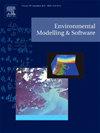一个简化水质模型的概率评估及其与湖泊水文特征的联系。
IF 4.6
2区 环境科学与生态学
Q1 COMPUTER SCIENCE, INTERDISCIPLINARY APPLICATIONS
引用次数: 0
摘要
简单的模型对于支持跨各个领域的工程应用的管理是有价值的,例如水资源和环境卫生。但是,应该认识到与这些方法有关的固有不确定性并加以量化,以便更好地支持决策。本研究评估了由两个主要因素引起的变异性:采用不同的数值方法和在一个用于四种不同水文条件下磷预测的完整搅拌槽式反应器(CSTR)模型中的参数变异性。采用综合多种数值方法的集成方法来评估数值不确定性。通过蒙特卡罗模拟评估了参数的不确定性。该研究仅侧重于描述不确定性,而没有评估模型的性能或将应用模型的结果与观测数据进行比较。数值和参数的不确定性范围在体积波动较小的储层中相似,而在体积随时间增加的储层中不同。观测到的不确定性的总体大小取决于分析期间的流体动力学。在评估涉及容量储存的季节变化或气候变化的潜在影响的情况时,选择数值方法尤为重要。结果支持了一个理论,即概率方法通过包含更广泛的可能结果来支持决策。此外,由于其简化的方法,概率分析提高了对建模结果的信心,即使在零维建模固有的简化。这个附加的分析层有助于解释不确定性,提高模型的整体可靠性,尽管它很简单。本文章由计算机程序翻译,如有差异,请以英文原文为准。
Probabilistic assessment of a simplified water quality model and its linkage to the hydrological characteristics of lakes
Simple models can be valuable for supporting the management of engineering applications across various fields, such as water resources and environmental sanitation. However, the inherent uncertainty associated with these approaches should be recognized and quantified to better support decision-making. This study assessed variability arising from two primary factors: the adoption of different numerical methods and parameter variability within a complete stirring tank reactor (CSTR) model applied for phosphorous predictions across four different hydrological conditions. An ensemble approach, integrating multiple numeric methods, was employed to evaluate numerical uncertainty. Parametric uncertainty was assessed through Monte Carlo simulations. The study focused solely on characterizing uncertainties without evaluating model performance or comparing the results from the applied models to observational data. The numerical and parametric uncertainty ranges were similar in reservoirs with low-volume fluctuations and differed in reservoirs where volume increased over time. The overall magnitude of observed uncertainty depended on the hydrodynamics during the analysis period. The choice of numerical approach is particularly important in assessing cases involving seasonal shifts in volumetric storage or potential impacts from climate change. Results supported the theory that a probabilistic approach supports decision-making by encompassing a wider range of possible results. Moreover, due to its simplified methodology, probabilistic analysis enhances the confidence in the modeling results, even with the inherent simplifications of zero-dimensional modeling. This added layer of analysis helps to account for uncertainties, improving the overall reliability of the model despite its simplicity.
求助全文
通过发布文献求助,成功后即可免费获取论文全文。
去求助
来源期刊

Environmental Modelling & Software
工程技术-工程:环境
CiteScore
9.30
自引率
8.20%
发文量
241
审稿时长
60 days
期刊介绍:
Environmental Modelling & Software publishes contributions, in the form of research articles, reviews and short communications, on recent advances in environmental modelling and/or software. The aim is to improve our capacity to represent, understand, predict or manage the behaviour of environmental systems at all practical scales, and to communicate those improvements to a wide scientific and professional audience.
 求助内容:
求助内容: 应助结果提醒方式:
应助结果提醒方式:


